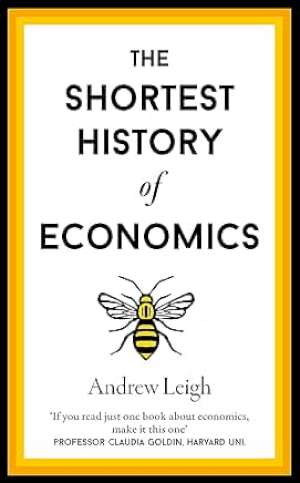03 July 2024
The Shortest History of Economics
Andrew Leigh
2024, Old Street Publishing, 228 pages,
ISBN 9781913083496
Reviewer: Ian Harwood

This is a fascinating and absorbing book which is thoroughly engaging and therefore difficult to put down. It is, moreover, relatively short, its main text comprising a mere 194 none-too-closely typed pages. The book’s scope, however, is extraordinarily ambitious. Indeed, in the author’s own words:
“This small book tells a big story. It is the story of capitalism – how our market system developed. It is the story of the discipline of economics, and some of the key figures which informed it. And it is the story of how economic forces have shaped world history.”
A self-confessed “congenital optimist”, Leigh charts the course of humanity’s material progress, identifying the principal driving forces behind the extraordinary improvements which have taken place not just in living standards but also in health, longevity and overall “happiness” over the course of many millennia – and most notably since the advent of the industrial revolution. Thus, Thomas Hobbes’ description of early human life as “solitary, poor, nasty, brutish and short” has become increasingly redundant with peoples’ lives having been transformed into something immeasurably better.
Innovative technology is depicted as playing the leading role in driving this change. To quote the author once more: “From the plough to the internet, technology has driven revolutions in economic activity.” Accounts of such innovations and their significance are skilfully integrated into the overall narrative.
Playing the critical enabling role, however, have been changes in the way economic activity has been organised, with the adoption of specialisation and the encouragement of trade especially important. And it is in this connection that the author adroitly weaves into his unfolding story the roles played by key economic concepts, notably: incentives, cooperation, comparative advantage, the operation of market forces, opportunity costs, trade-offs, externalities, market failures and behavioural psychology.
The story told is a compelling one – and a “good read” to boot. Furthermore, it is a story enlivened by the successive introduction of a cast of influential economists – starting with Adam Smith, going on to include many of the nineteenth and twentieth century “greats” and concluding in the present century with Stern, Goldin, Kahneman and Chetty – who have, via their fresh insights, materially improved our understanding of the way in which market economies work.
As part of Old Street Publishing’s “Shortest History” series the text – consisting of fourteen chapters – is necessarily short and admirably tightly edited. Inevitably, though, such an approach risks skating too lightly over the surface of key developments and falling prey to over-simplification.
Much to my surprise, therefore, the Wall Street Crash of 1929 is accorded the leading role in producing the Great Depression – an interpretation seriously at odds with the findings of modern scholarship.
Equally surprisingly, the Great Inflation of the 1970s receives only passing mention – and even less analysis of its various causes – despite its traumatising impact. As far as the subsequent quashing of high inflation is concerned, moreover, the “good policy” pursued by central bankers is accorded all the credit, with no mention whatever of the important role also played by “good luck” such as the absence of large-scale adverse 1970s-style commodity price shocks and China’s rapid integration into the global economy.
As for the global financial crisis of 2008 – a “watershed” moment if ever there was one – it receives scant discussion.
Disappointingly, too, the references at the back of the book are hardly copious. And any reader seeking further enlightenment on the manifold topics discussed receives no guidance. In this regard a “recommendations for further reading” section would have constituted a helpful addition for those who wished to delve further into the manifold topics discussed. Something perhaps for a second edition?
Who should read this book? The most obvious target audience is the general reader who will welcome the succinct, incisive and wide-ranging narrative. But trained economists, too, will enjoy the journey.
